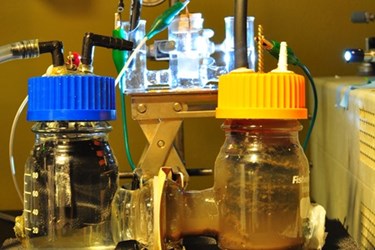Using Wastewater And Sunlight To Generate Clean Energy

By Laura Martin

Searching for a clean energy solution, chemistry professor Yat Li turned to water splitting—separating water into oxygen and hydrogen to create hydrogen fuel.
But the concept of “wasting” drinking water bothered Li, who works at the University of California, Santa Cruz.
“Clean water is a very valuable resource,” says Li. “So we decided to try and do it with wastewater instead, and create a process to recover the energy while cleaning the water at the same time.”
To do this in the most energy-efficient way possible, Li utilized two devices: a solar cell called a photoelectrochemical cell (PEC) and a microbial fuel cell (MFC). The PEC uses the concentrated power of the sun to split water, while the MFC uses electrogenic bacteria to clean the wastewater and generate energy. While both systems can create hydrogen fuel individually, together they have much greater potential, says Li.
“The barrier we had was that we needed to apply external energy to generate hydrogen fuel for either device,” says Li. “By interfacing these two devices together as a solar-microbial device, we are able to generate hydrogen with just wastewater and sunlight and no outside energy.”
Currently the PEC-MFC device is still in the experimental stages, but results are promising, says Li. When fed with wastewater and illuminated in a solar simulator, the device showed continuous production of hydrogen gas at an average rate of 0.05 cubic meters per day. Soluble chemical oxygen demand (COD) declined by 67 percent over 48 hours, according to a report published by UC Santa Cruz.
Because it is operating on a small scale, there are currently limits to the device’s efficiency. The rate at which the wastewater is cleaned needs to be improved, says Li.
“We start with black wastewater, and we can eventually turn it almost colorless, but it takes almost a month,” he says. “This is related to the rate of bacteria activity, so we need to speed up bacteria growth. We are really looking to optimize this process.”
A full-scale wastewater treatment facility with a continuous flow of wastewater and a wide range of bacteria should significantly improve bacterial growth, says Li. He and his team are preparing to scale up their hybrid device and collaborate with a municipal wastewater treatment facility to set it up on site.
“Right now the focus is to demonstrate this idea scientifically on a large scale to see if it can work,” says Li. “It is definitely a potential sustainable solution to energy efficiency. “
To read more about hydrogen fuel and other energy generating treatment technologies, check out previous coverage on Water Online:
Electricity-Producing Microbes Treat Wastewater, Provide Power Source
Water Remediation ‘Robots' Feast On Over 400 Wastewater Contaminants, Then Self-Destruct
